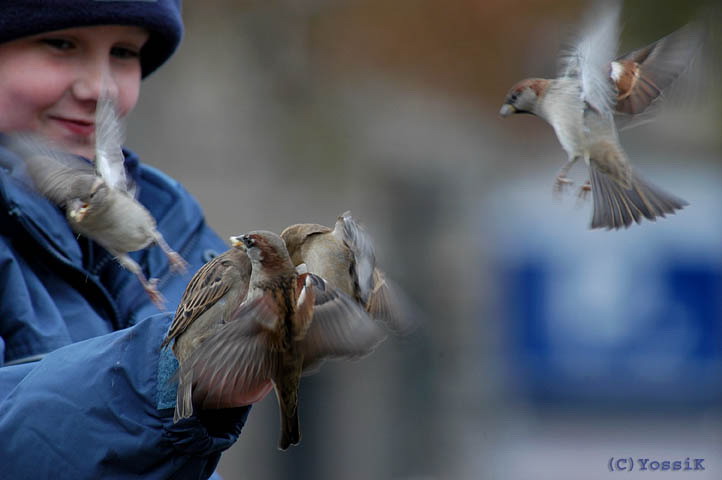|
We were all educated to think that a picture should be loaded with details, the more the merrier. A long time ago, when film was expensive, we tried to “pack” as much as we could into one picture.
We would not leave any member of the group outside the frame, even if that meant moving 100 meters backwards. Common knowledge had it that a photograph, that was not defined as a portrait, and included only one subject, was a waste. This is not true, especially today – when the digital camera eliminates the need to calculate the cost of each frame. Whether one has a simple or very expensive digital camera, one can take as many pictures as one desires, so there is no excuse nowadays. But what pictures should we take? Should we travel far and wide to “catch a good picture”? Not necessarily. One can find exciting photo opportunities in ones own back yard, down the next street, and even at home; one just has to see it.
A picture needs a subject, but what is a subject?
The answer is simple – anything we see and like for esthetic reasons, or anything that emotionally touched our heart is a proper subject. Or anything that caught our attention, or is worthy of our attention is a subject.
Now all we have to do is to catch that subject with our camera, and freeze it so we can take this stimulating event with us.
This provides the greatest test for the photographer’s technical capability. How one can use this tool to freeze the exciting moment, so when one sees the picture again, or shows it to others, one can go back to the thrilling experience one witnessed.
I like simple subjects that do not pop into my eye at first sight.
In the attached picture, the subject isn’t the sparrows but the curious/happy face of the child and his joy in feeding the sparrows.
This picture breaks several rules, but what are rules for, if not to be broken. The first rule – the subject must be sharp. Actually no. If the subject is apparent, it does not need to be sharp to cross through. If I had focused on the child, the sparrows would come out fuzzy due to their size.
The sparrows too, do not show sharp and clear. This was done intentionally by choosing the lens’s focal length (400mm) and a relatively low exposure speed – 1/125 of a second, which does not freeze the movement.
I wanted to pass through the dynamic motion of the sparrows flying over, landing on this child’s hand to pick at the crumbs, and immediately taking off. Even one sharp point is sufficient to pass on the message well (if the entire picture is blurry, we get a feeling that something was missed, unless the blurriness is harmonious, but this I will leave for another time). The sharp point is the child’s hand, and the back of one of the landing sparrows.
Another broken rule is cutting the frame or the partial appearance of the subject, like the sparrow on the right. This was done intentionally to pass on the dynamic movement to and from the child. The entire frame is full of life – take-off, landing and so on and it all came through due to the technique I used.
Another rule I overlooked states that a picture should be colored with rich hues. In this picture, the simplicity comes through thanks to the poor colors: the child’s pink and blue, and the sparrows’ brown. The reduced colors attract us to the subject itself, and do not let our attention wander elsewhere.
Certain composition rules were maintained – the child’s eyes and the bird in the air are located in the “golden points” of composition. In this picture, our eye skips from the flying sparrow to the child’s face and eyes, to his open hand and to the sparrows leaving the frame and so on and so forth. This rule is maintained by arranging the picture in advance, placing the child at the correct point and waiting for the second a sparrow enters the second point.
This took about 30 seconds, which is not too bad.
Using a long focal length and an open aperture also helped isolate the subject of its surroundings, and to blur and keep the interfering elements out of the frame – and there were plenty of that kind.
To break the rules, you have to know them – and be aware of the benefits and cost of breaking the rules. It is easy to miss such a photo – if you focus on the wrong thing or use an improper technique.
The main subjects – the happiness and concentration on the child’s face while feeding the birds, together with the dynamic movements of the sparrows on his hand - came through very well in this picture, in my opinion.
This picture was taken in cold Paris, in autumn (at the end of October), near the Notre Dam. The tools were: a Nikon digital D100 and an 80-400mm zoom lens.  | | Model: NIKON D100 Exposure Time: 1/160sec F Number: 6.3 Max Aperture Value: 5 Focal Length: 400mm Exposure Program: Aperture priority Exposure Bias Value: 0.3333333 Metering Mode: Center Weighted Average White Balance: Auto white balance Flash: Flash did not fire Focal Length In 35mm Film: 600 Date Taken: 2003:10:20 17:29:02 Color Space: sRGB |
|





